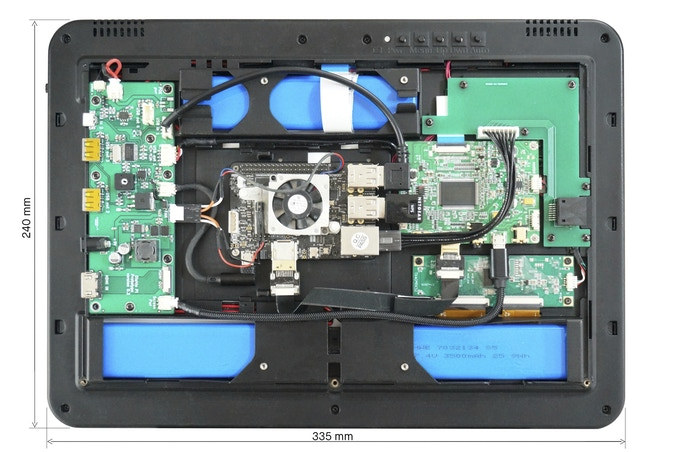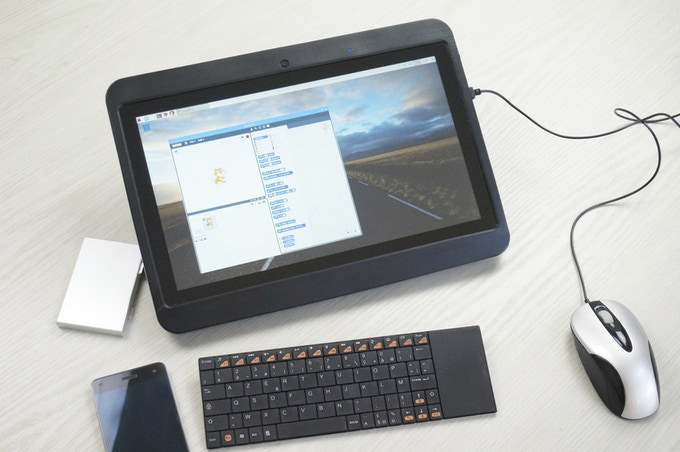Diskio Pi was a DIY tablet kit for Raspberry Pi, ODROID-C2/XU4 and other compatible boards with a 13.3″ Full HD display that launched last year on Kickstarter. But the project failed likely due to the high costs (350 Euros and up for early bird pledges without battery nor SBC) and an elevated funding target of 400,000 Euros.
But the team did not give up, worked on reducing costs, improved the design, and recently relaunched Diskio Pi on Kickstarter with a more achievable 52,096 Euros target, and reasonable pricing with rewards starting at 189 Euros including VAT.
Diskio Pi “basic” DIY tablet kit content and main specifications:
- Display – Innolux 13.3″ TFT/IPS display with 1920×1080 resolution, WLED backlight + 10-point touch capacitive panel connected over USB 2.0
- Video control board with HDMI 1.4 to eDP converter, stereo amplifier, and 2x 1W speakers
- Daughter board with Genesys USB hub, 9V to 5V/4A buck converter, temperature control, HDMI external output
- Ethernet and audio board with Ethernet jack and 3.5 stereo audio jack
- Internal cables for Raspberry Pi (1, 2, 3 B/B+ and Zero W, WH), Odroid-C1+, C2, including Ethernet & HDMI internals cables.
- Internal ribbon cable & connector for external HDMI input
- AC/DC power adapter with EU, UK or US cable1
- Screws and a small screwdriver
- ABS case without the stand, 2x racks plates & nylon spacers, IP20 rating
- Assembly instructions
External ports includes 2x USB 2.0 host ports up to 500 mA, a 9V DC jack, HDMI, Ethernet, and USB power out (2.5A). There are also some status LEDs and OSD/power buttons on the unit, and support for Raspberry Pi camera (not included).

There are also optional items like a charging circuit with either the battery pack light (4 LiPo cells 7.4V/7,000mAh) or the battery pack full (6 LiPo cells 7.4V/10,500mAh). The tablet weights 1275 grams without battery, or 1,525 grams / 1,650 grams with the respective light / full battery packs. More options can be unlocked if stretch goals are met, including a tablet stand and/or a custom designed fansink.
Beside supporting various Raspberry Pi and ODROID board, Intel Atom X5 based UP Board has also been tested with the kit. Everything is sent as a kit, and assembly takes around 2 hours.
As mentioned in the introduction, rewards start at 189 Euros inc. VAT for Diskio Pi Basic without batteries. If instead, you’d rather get the basic kit plus the 4-cell battery pack, a pledge of 216 Euros is required. Shipping adds 8 Euros to France, 16 Euros to most of Europe, and 36 Euros to the rest of the world. For the latter, you are not supposed to be charged VAT, so I’m not exactly sure how they plan to handle that part. Delivery is scheduled for August 2019, so you’d need to be patient…

Jean-Luc started CNX Software in 2010 as a part-time endeavor, before quitting his job as a software engineering manager, and starting to write daily news, and reviews full time later in 2011.
Support CNX Software! Donate via cryptocurrencies, become a Patron on Patreon, or purchase goods on Amazon or Aliexpress





